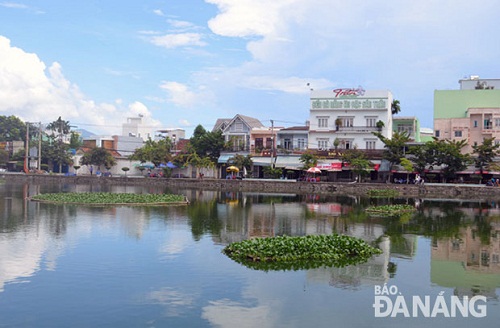Better solutions needed to resolve pollution in urban lakes
There are now 18 urban lakes in Da Nang, and the majority of them are located in the districts of Thanh Khe, Hai Chau and Cam Le.
In the past, a large volume of domestic effluent from residential areas nearby was discharged into the lakes, and their sluice gates were blocked by rubbish. As a result, the lakes became serious environmental pollution hotspots at that time.
In an attempt to deal with the problem, the city’s Urban Environment Company and the Water Drainage and Wastewater Treatment Company have jointly taken many effective measures to deal with the problem of environmental pollution in the Thac Gian and Vinh Trung lakes in Thanh Khe District.
 |
| Vinh Trung lake - an airy and peaceful space in the city |
The focus has been on dredging the thick sludge out of the lakes and growing patches of ‘beo luc binh’ (Eichhorina crassipes) in the lakes in order to give them a higher aesthetic value, alleviate the sickening stench wafting off the lakes, and create an airy space. Also, importance has been attached to increasing the awareness of environmental protection amongst local residents, and encouraging them to become actively involved in cleaning up the environment around the lakes to implement the city’s ‘Green, Clean and Beautiful Sunday’ campaign. Thanks to these activities, the environmental pollution problems at these hot spots have been solved.
Meanwhile, businesses in Thank Khe District have pledged to implement the city’s regulations about protecting local water resources and not discharging large volumes of untreated effluent into the other lakes under the management of the district’s authorities, such as Xuan Hoa A and a 2ha lake. In particular, strict penalties have been imposed on any company found committing environmental violations.
However, it is expected that pollution in these urban lakes will increase in the near future due to the city’s harsh weather conditions, with fierce heatwaves and prolonged heavy rain, if suitable management measures are not initiated very soon.
Dr Tran Van Quang from the Environmental Science Faculty of the city’s University of Technology recently presented 2 solutions to protect the environment in the lakes.
The first involves collecting the wastewater flow into man-made layers of sand and macadam on which trees have been planted before discharging it into the lakes. With this method, the suspended solids are retained and gradually decomposed by micro-organisms in the layers.
His second suggestion is called the ‘Multifunctional Vegetated Floating Island’ method. This multifunctional ecological engineering facility aims to improve the water quality, offer scenic beauty, and preserve an ecosystem by providing habitats and spawning grounds for zooplanktons and fish. The plants on the constructed floating island can absorb nutritive salts, and the micro-organisms attached to string biological media hanging below the island will decompose the contaminants in the lakes.